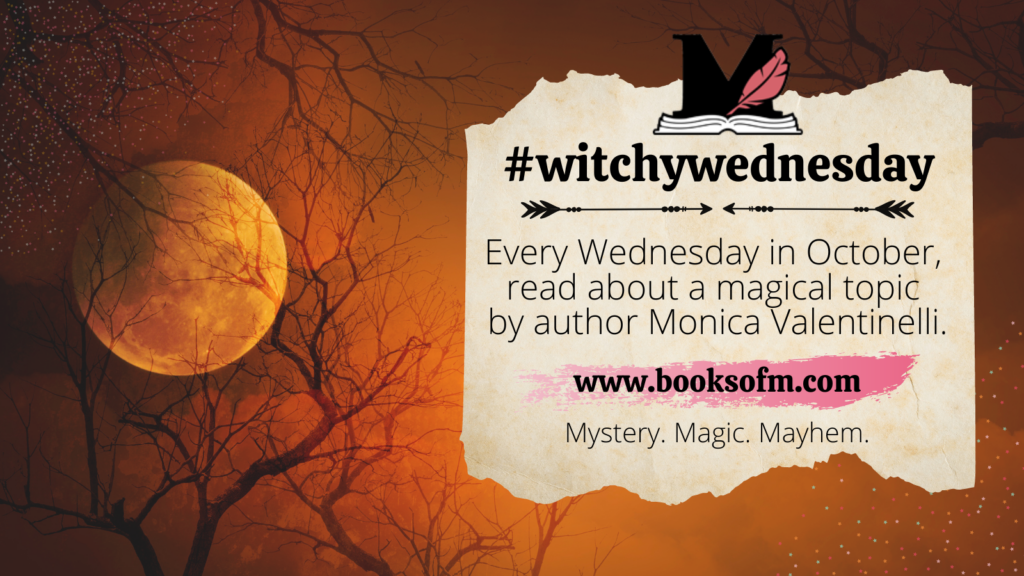Colonial American Witch Trials for Witchy Wednesday
Posted on October 9, 2024 by Monica Valentinelli

True to the #WitchyWednesday theme, I wanted to share historical insight about witches and witch trials in Colonial America. There are several nuances to this conversation, because there’s so many cultural aspects that intersect with the topic; additionally, definitions of the “witch” shift depending upon the decade and century. This topic is so huge, I’m going to focus on the American witch trials, add some pointed commentary, and offer some accessible, online resources that are free-to-read (or watch).
Before I go any further, I want to point out that some people may find the information in this essay deeply upsetting, because I touch on violence, murder, race, and human slavery.
What most Americans conjure when they think of a witch is drawn from pop culture, and this is both evident and shaped by the current zeitgeist. The Salem Witch Trials, for example, have been omnipresent in 20th century media–the first movie about the Salem Witch Trials was Salem’s Maid (1937), a movie that blends romance with horror. Depictions of the romantic aspect, a common occurrence in European witch trials, is prominent in pop culture–but not American history. Salem’s Maid (1937) was likely influenced by one of America’s first, mass-produced books: The Scarlet Letter (1850) by Nathaniel Hawthorne, a descendant of Judge John Hathorne. Reputedly, Hawthorne changed the spelling of his surname to add the “w” because he was embarrassed by his ancestor’s role in the Salem Witch Trials.
Despite its coverage and pop culture influences, misconceptions about the Salem Witch Trials persist. Unfortunately, there’s precious little information or perspectives written about the Black people wrapped up in that particular hysteria. Tituba, whose identity has been proposed as Native American or African, was married to John Indian and had a daughter named Violet. They were enslaved to the Puritan minister, Samuel Parris, whose daughters accused Tituba of witchcraft. The fact that Tituba was married and had a child is often erased; few books have been written about her by authors of color, too.
The dearth of information is due to a number of factors. One of the reasons why the Salem Witch Trials are so well covered is because the event is well documented. At the time, enslaved peoples were referred to as “servants,” but their documentation was not treated the same as the colonists were. Sometimes, a “servant’s” biographic information would be listed under the “owner’s” property. In other words, if you want to get a complete picture of the demographics in a specific area, you’d have to broaden your research to specifically include BIPOC-related data and correspondence.
Too, historians haven’t always provided an intersectional viewpoint of events. To regard the Salem Witch Trials from a BIPOC author’s lens, you might have better luck asking a scholar from the African-American Studies department about what happened. This dimension, unfortunately, has yet to be integrated into history departments. Though we are starting to see intersectional feminist depictions and queer depictions, of witches–we have yet to discuss the colonial violence and the literal demonization of BIPOC women–a foundational, colonial view of witchcraft.
Witchcraft, in general, is a complicated topic because, for centuries, magic was a cauldron of disciplines stirred with faith. Meterology, botany, chemistry, biology, etc. were all considered from a magical lens, that opposing forces of the divine and the malevolent were responsible for positive and negative outcomes. The demonization of BIPOC cultures occurred to justify colonial violence and enslavement.
Today, this truth is being added slowly–if you know where to look. The Salem Witch Museum, for example, relays that two other enslaved women–Candy and Mary Black–were accused during the Salem Witch Trials, but were exonerated.
Prior to the events of Salem Village, however, there were other witch trials that occurred on colonial soil (namely in Connecticut Colony) and these trials ran concurrent with European hysterias–with one, significant difference. Many of the murdered victims in the American colonies, as Kali Nicole Gross pointed out in the Washington Post (linked below), were black, enslaved women.
As urban legends often go, the truth about the witch trials in America is far more horrific and complicated than anything we could imagine. Two, important facts often get missed or downplayed. As I’ve relayed here, the victims were not always white. Secondly, any beliefs in witchcraft and the resulting hysterias on colonial soil did not occur in isolation. The English colonists carried their beliefs with them; they didn’t simply abandon their cultures and stopped communicating with other Europeans just because they landed on a different shore.
Thank you for reading this deep dive into a gruesome aspect of American history and witchcraft. Here are some online resources you can read and watch to understand more.
If you’re enjoying this series, drop a comment, sign up for my newsletter, or buy me a coffee. Your support is appreciated!
Special thanks to K. Tempest Bradford from Writing the Other for reviewing a draft of this essay.
Additional Resources
Here is a list of articles and videos that you can read online to gain a deeper understanding of this dark chapter.
darientimes.com/news/article/How-America-s-witch-trials-began-in-16562145.php
time.com/4543405/connecticut-witch-trials
New documents reveal shocking discoveries into Connecticut’s witch trials (video)
salemwitchmuseum.com/2022/02/18/remembering-candy-and-mary-black
enslaved.org/fullStory/16-23-126811
washingtonpost.com/opinions/2022/02/25/black-women-history-burned-at-stake
britannica.com/topic/witchcraft
archives.gov/research/african-americans/slavery-records.html
library.northshore.edu/Hawthorne_Family
princeton.edu/~jweisenf/northstar/volume8/white.pdf
Tags | salem, witches, witchywednesday

